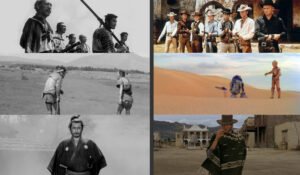Akira Kurosawa on Japanese and World Cinema
Akira Kurosawa, one of the most influential filmmakers in history, transformed Japanese cinema and left a lasting mark on world cinema. His innovative storytelling, visual style, and deep characters set new standards in the film industry. From his early works to his international successes, Kurosawa’s impact continues to inspire filmmakers around the globe. Let’s explore how Akira Kurosawa shaped both Japanese and world cinema.
Kurosawa’s Early Influence on Japanese Cinema
Kurosawa began his career in the 1940s, quickly gaining recognition for his unique vision. His films often explored themes of human struggle, honor, and morality. Kurosawa didn’t shy away from complex characters and emotional depth, setting his work apart from many of his contemporaries. Movies like “Rashomon” and “Ikiru” showcased his talent for crafting compelling narratives that resonated deeply with audiences. His approach to storytelling helped elevate Japanese cinema, bringing it to a new level of artistic expression.

Breaking Boundaries with “Rashomon”
“Rashomon,” released in 1950, became a groundbreaking film that brought Kurosawa international fame. The film’s unique narrative structure, which tells the same story from different perspectives, was revolutionary at the time. It challenged traditional storytelling techniques and encouraged audiences to question the nature of truth. “Rashomon” won the Golden Lion at the Venice Film Festival, marking the first time a Japanese film received such a prestigious international award. This success not only boosted Kurosawa’s career but also shone a spotlight on Japanese cinema worldwide.
Kurosawa’s Mastery of Visual Style
Kurosawa’s visual style played a crucial role in his impact on cinema. He often used dynamic camera movements, bold compositions, and striking use of weather elements like rain and wind to heighten the emotional intensity of his scenes. His ability to convey mood and emotion through visuals set a new standard for filmmakers. Movies like “Seven Samurai” and “Yojimbo” displayed his mastery of blending action with storytelling, influencing directors in Japan and beyond.
Influencing Filmmakers Worldwide
Kurosawa’s influence extended far beyond Japan. Many renowned filmmakers, including George Lucas, Steven Spielberg, and Martin Scorsese, have cited Kurosawa as a major influence on their work. George Lucas, for example, drew inspiration from Kurosawa’s film “The Hidden Fortress” when creating “Star Wars.” Kurosawa’s emphasis on strong character development, visual storytelling, and innovative techniques inspired countless directors to push the boundaries of their own work.
Introducing Japanese Culture to Global Audiences
Through his films, Kurosawa introduced Japanese culture, values, and stories to audiences worldwide. His portrayal of samurai, in particular, became iconic, shaping the global image of Japanese history and traditions. Films like “Throne of Blood,” a retelling of Shakespeare’s “Macbeth” set in feudal Japan, combined Japanese aesthetics with universal themes. This fusion made his films accessible to international viewers, bridging cultural gaps and broadening the appeal of Japanese cinema.
Kurosawa’s Legacy in Modern Cinema
Even decades after his prime, Kurosawa’s influence remains evident in modern cinema. Filmmakers continue to draw inspiration from his storytelling techniques, character arcs, and visual style. His approach to exploring human nature and moral dilemmas remains relevant, resonating with new generations of audiences. Kurosawa’s legacy endures not just in the films he made but in the countless movies that have followed in his footsteps.
Conclusion
Akira Kurosawa’s impact on Japanese and world cinema cannot be overstated. He revolutionized storytelling, elevated the art of filmmaking, and inspired generations of directors across the globe. His films broke cultural barriers, introduced Japanese cinema to the world, and set new standards for the industry. Kurosawa’s legacy lives on, reminding us of the power of film to tell stories that transcend time and place. As we continue to explore his work, we celebrate the lasting influence of a true cinematic master.



